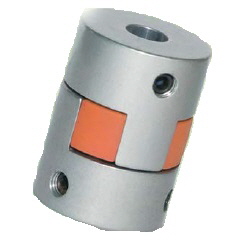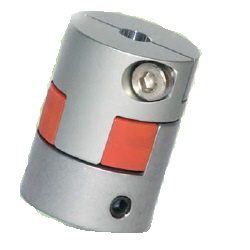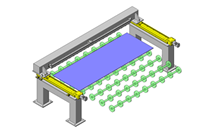(!) Since support from Microsoft will end on January 14th, 2020, Windows 7 will be excluded from the recommended environment from December 15th, 2019 on this site. Vì lý do Microsoft kết thúc hỗ trợ cho Windows 7 vào ngày 14/01/2020, Windows 7 sẽ là hệ điều hành không được khuyến khích sử dụng với trang web này từ ngày 15/12/2019.
Search by Category / Brand Tìm theo danh mục, nhãn hiệu
Search by Category Tìm theo danh mục
- Thông báo: Cập nhật hệ thống Hải quan và Thuế có thể gây chậm trễ trong giao hàng. Xem chi tiết.
- Thể lệ và Giải thưởng cuộc thi "Thiết kế máy Tự động hóa 2025" do MISUMI Việt Nam tổ chức. Xem chi tiết.
JIT COUPLING Flexible Shaft Couplings(Type:Jaw)
JIT COUPLING offers products Flexible Shaft Couplings specified by Type Jaw from Automation Components product category. There are a total of 3 items. Search and select detailed specifications of parts for your machine with free CAD download. JIT COUPLING products are available to order through MISUMI on
JIT COUPLING offers products Flexible Shaft Couplings specified by Type Jaw from Automation Components product category. There are a total of 3 items. Search and select detailed specifications of parts for your machine with free CAD download. JIT COUPLING products are available to order through MISUMI online 24/7. Free shipping, no minimum order.
|
Type
|
|
|---|---|
Brand |
|
| CAD |
|
| Days to Ship |
|
3 itemsMặt hàng
- Sort By
-
You can add up to 6 items per a category to the compare list.

Jaw Coupling, Clamping-Screw Type JC-C
JIT COUPLING
[Features]·The Jaw Coupling is manufactured by making 2 to 4 protrusions on a cylindrical aluminum material and inserting highly elastic polyurethane material (SH98A) between the protrusions to maximally absorb the impact generated by sudden rotation and braking·It has a structure that is very easy to disassemble and assemble, and since the intermediate medium is an insulator, it has the effect of blocking electrical noise[Applications]·S...Readmore
Type Shaft Bore Dia. (machined) D1(Ø) Shaft Bore Dia. (machined) D2(Ø) Outer Dia. A(Ø) Overall Length W(mm) Application Allowable Torque Range(N•m) Features Allowable Misalignment Max. Rotational Speed Range(r/min) Body Material Allowable Torque(N•m) Allowable Angular Misalignment(deg) Allowable Lateral Misalignment(mm) Product Category Allowable Lateral Misalignment Range(mm) Max. Rotational Speed(r/min) Buffer Material Disc Material Bellows Material Characteristics/Applications Environmentally friendly Jaw 3 ~ 45 3 ~ 45 16 ~ 80 23.6 ~ 114 - - - - - Aluminum - 1 0.1 ~ 0.2 - - 2500 ~ 9000 Polyurethane - - - - From: 336,080 VND Days to Ship: Số ngày giao hàng: Same day or more  Same day or more
Same day or more
-
You can add up to 6 items per a category to the compare list.

Jaw Coupling, Set-Screw Type JC-S
JIT COUPLING
[Features]· Divided into two hubs to facilitate processing of the key-way; the tightening angle of the fixing bolt is set to 120° intervals, enabling it to be mounted safely.[Usage]· Can be used for a wide range of general industrial machines, such as compact geared motors and compact DC motor-powered pumps.· Suitable for machines that are often assembled and disassembled, or those subject to frequent forward / reverse movements.
Type Shaft Bore Dia. (machined) D1(Ø) Shaft Bore Dia. (machined) D2(Ø) Outer Dia. A(Ø) Overall Length W(mm) Application Allowable Torque Range(N•m) Features Allowable Misalignment Max. Rotational Speed Range(r/min) Body Material Allowable Torque(N•m) Allowable Angular Misalignment(deg) Allowable Lateral Misalignment(mm) Product Category Allowable Lateral Misalignment Range(mm) Max. Rotational Speed(r/min) Buffer Material Disc Material Bellows Material Characteristics/Applications Environmentally friendly Jaw 3 ~ 22 3 ~ 22 16 ~ 42 23.6 ~ 55 Standard / Servo Motor / Stepping Motor - High Durability ~ Vibration Insulation - - Aluminum - 1 0.1 ~ 0.2 - - 3000 ~ 9000 Polyurethane - - - - From: 265,100 VND Days to Ship: Số ngày giao hàng: Same day or more  Same day or more
Same day or more
-
You can add up to 6 items per a category to the compare list.

Jaw Coupling, Clamping Screw / Set Screw Combined Type JC-CS
JIT COUPLING
[Features]· The JC-CS Type Coupling uses a clamp-type on one side and a set screw on the other side to facilitate mounting.· The main body is made of highly rigid aluminum (AL705-6T).· Highly elastic polyurethane is adopted for the ring gear used as an intermediate medium.· The surface is anodized and has excellent corrosion resistance.
Type Shaft Bore Dia. (machined) D1(Ø) Shaft Bore Dia. (machined) D2(Ø) Outer Dia. A(Ø) Overall Length W(mm) Application Allowable Torque Range(N•m) Features Allowable Misalignment Max. Rotational Speed Range(r/min) Body Material Allowable Torque(N•m) Allowable Angular Misalignment(deg) Allowable Lateral Misalignment(mm) Product Category Allowable Lateral Misalignment Range(mm) Max. Rotational Speed(r/min) Buffer Material Disc Material Bellows Material Characteristics/Applications Environmentally friendly Jaw 3 ~ 22 3 ~ 22 16 ~ 42 23.6 ~ 55 Standard / Servo Motor / Stepping Motor - High Durability ~ Vibration Insulation - - Aluminum - 1 0.1 ~ 0.2 - - 3000 ~ 9000 Polyurethane - - - - From: 298,010 VND Days to Ship: Số ngày giao hàng: Same day or more  Same day or more
Same day or more
Loading...Tải…
ConfigureTạo
Specification/DimensionsĐặc điểm kỹ thuật / Kích thướcĐặc điểm kỹ thuật / Kích thước
-
Shaft Bore Dia. (machined) D1(Ø)
-
Shaft Bore Dia. (machined) D2(Ø)
-
Outer Dia. A(Ø)
- 5.9
- 6
- 6.4
- 7.9
- 8
- 9
- 9.5
- 9.9
- 10
- 11.9
- 12
- 12.7
- 13
- 13.5
- 13.8
- 14
- 14.5
- 15
- 16
- 16.1
- 16.5
- 16.6
- 16.8
- 17
- 17.5
- 17.8
- 18
- 19
- 19.1
- 19.5
- 19.6
- 20
- 21
- 22
- 22.2
- 22.5
- 23.8
- 24
- 24.5
- 25
- 25.4
- 25.5
- 26
- 26.2
- 26.5
- 26.6
- 27
- 27.3
- 28
- 28.8
- 29
- 29.5
- 30
- 31.7
- 31.8
- 32
- 32.8
- 33
- 33.3
- 34
- 34.4
- 34.5
- 35
- 36
- 37.8
- 38
- 39
- 39.5
- 40
- 41.0
- 41.3
- 42
- 42.5
- 42.8
- 43
- 44
- 44.5
- 44.8
- 45
- 46
- 47
- 48
- 49
- 50
- 53
- 53.6
- 54
- 54.5
- 54.8
- 55
- 56
- 57
- 58
- 60
- 63
- 64
- 65
- 66
- 68
- 69
- 69.9
- 70
- 73
- 75
- 79
- 79.5
- 80
- 81
- 82
- 83
- 85
- 87
- 88
- 90
- 93
- 94
- 94.5
- 95
- 99
- 100
- 102
- 104
- 104.5
- 105
- 112
- 117
- 118
- 120
- 125
- 126
- 135
- 138
- 140
- 143
- 144
- 150
- 152
- 155
- 160
- 161
- 168
- 170
- 178
- 185
- 190
- 194
- 200
- 210
- 214
- 225
- 246
- 262
- 276
- 308
- 346
-
Overall Length W(mm)
- 5.1
- 7.3
- 8.4
- 9
- 9.4
- 9.6
- 9.8
- 10
- 10.2
- 10.4
- 10.5
- 11.2
- 11.4
- 11.8
- 11.9
- 12
- 12.35
- 12.4
- 12.7
- 13
- 13.5
- 14
- 14.2
- 14.4
- 14.5
- 14.6
- 14.7
- 14.9
- 15
- 15.4
- 15.5
- 15.6
- 15.7
- 15.8
- 15.9
- 16
- 16.2
- 16.5
- 16.6
- 16.7
- 17
- 17.4
- 17.5
- 17.6
- 17.8
- 17.9
- 18
- 18.1
- 18.4
- 18.5
- 18.7
- 18.8
- 19
- 19.1
- 19.2
- 19.35
- 19.4
- 19.6
- 19.7
- 19.8
- 20
- 20.2
- 20.4
- 20.5
- 21
- 21.1
- 21.2
- 21.3
- 21.4
- 21.5
- 21.6
- 22
- 22.1
- 22.2
- 22.4
- 22.5
- 22.8
- 23
- 23.05
- 23.1
- 23.15
- 23.2
- 23.3
- 23.4
- 23.5
- 23.6
- 23.9
- 24
- 24.1
- 24.2
- 24.4
- 24.5
- 24.9
- 25
- 25.4
- 25.45
- 25.5
- 25.6
- 25.7
- 25.9
- 26
- 26.1
- 26.2
- 26.5
- 26.6
- 27
- 27.2
- 27.3
- 27.4
- 28
- 28.1
- 28.2
- 28.3
- 28.4
- 28.5
- 28.8
- 29
- 29.4
- 29.5
- 29.8
- 30
- 30.2
- 30.4
- 30.5
- 31
- 31.2
- 31.4
- 31.5
- 31.6
- 31.7
- 31.8
- 32
- 32.2
- 32.3
- 32.5
- 32.6
- 32.7
- 32.8
- 33
- 33.2
- 33.3
- 33.5
- 33.6
- 33.8
- 34
- 34.1
- 34.2
- 34.3
- 34.4
- 34.5
- 35
- 35.5
- 35.6
- 36
- 36.1
- 36.4
- 36.5
- 36.8
- 37
- 37.2
- 37.4
- 37.5
- 37.8
- 38
- 38.2
- 38.4
- 38.5
- 38.6
- 39
- 39.2
- 39.4
- 39.5
- 39.7
- 39.8
- 40
- 40.5
- 41
- 41.8
- 42
- 42.2
- 43
- 43.2
- 43.4
- 43.5
- 43.6
- 43.8
- 44
- 44.2
- 44.5
- 44.7
- 44.8
- 45
- 45.1
- 45.2
- 45.3
- 45.5
- 46
- 46.1
- 46.4
- 46.6
- 47
- 47.1
- 47.2
- 47.6
- 48
- 48.4
- 49
- 49.2
- 49.4
- 49.7
- 50
- 50.2
- 50.5
- 50.6
- 50.8
- 51
- 51.2
- 51.3
- 51.4
- 52
- 52.8
- 53
- 53.1
- 53.2
- 53.3
- 53.4
- 53.6
- 54
- 54.1
- 54.3
- 54.4
- 54.5
- 54.6
- 55
- 55.5
- 56
- 56.1
- 56.2
- 56.5
- 56.6
- 56.8
- 57
- 57.5
- 58
- 58.2
- 58.3
- 58.5
- 58.6
- 59
- 59.4
- 59.7
- 59.8
- 59.9
- 60
- 60.4
- 60.5
- 60.8
- 61
- 61.2
- 62
- 63
- 63.4
- 63.5
- 63.6
- 63.7
- 63.8
- 64
- 64.8
- 65
- 65.4
- 65.6
- 66
- 66.4
- 66.6
- 66.7
- 66.8
- 67
- 67.1
- 67.5
- 68
- 68.3
- 68.5
- 68.6
- 68.7
- 68.8
- 69.2
- 69.5
- 69.6
- 69.8
- 70
- 70.5
- 70.6
- 70.7
- 70.9
- 71
- 71.2
- 71.4
- 72
- 72.4
- 73
- 73.3
- 74
- 74.4
- 74.8
- 75
- 75.5
- 75.6
- 75.8
- 75.9
- 76.2
- 77
- 77.2
- 77.6
- 77.8
- 78
- 78.8
- 79.5
- 79.8
- 80
- 80.8
- 81
- 81.5
- 81.8
- 82
- 82.5
- 82.6
- 82.8
- 83
- 83.6
- 84
- 84.7
- 85
- 85.2
- 85.5
- 85.6
- 86
- 87.6
- 88
- 89.2
- 89.3
- 89.5
- 89.6
- 89.8
- 89.9
- 90
- 90.5
- 90.8
- 91
- 92
- 93.6
- 94
- 95
- 95.6
- 96
- 96.6
- 97
- 97.2
- 98
- 98.5
- 98.6
- 98.7
- 99
- 99.2
- 99.6
- 100
- 100.2
- 101
- 101.6
- 102
- 102.5
- 104
- 104.4
- 105.8
- 106
- 107.6
- 108
- 109
- 110
- 111
- 112.8
- 113
- 113.4
- 114
- 114.2
- 115
- 115.6
- 117.6
- 118
- 118.4
- 118.8
- 119.6
- 120
- 120.8
- 121
- 123.6
- 124
- 125
- 126
- 127
- 129
- 129.6
- 130
- 131
- 136.4
- 137.6
- 138
- 138.7
- 140
- 141
- 144
- 144.2
- 146
- 147
- 150
- 150.6
- 153.0
- 154
- 154.6
- 156.4
- 160
- 164
- 164.6
- 170.6
- 176
- 178.4
- 182.8
- 185
- 192.4
- 193
- 200
- 208.8
- 209.2
- 210
- 216
- 217
- 218
- 223
- 238
- 241.2
- 249.4
- 260
- 286.8
- 290
- 307.0
- 335
- 337.2
- 377
- 391
- 421
- 607
-
Application
- Standard
- Servo Motor
- Stepping Motor
- Encoder
-
Allowable Torque Range(N•m)
-
Features
-
Allowable Misalignment
-
 Not Provided
Not Provided -
 Angular Misalignment
Angular Misalignment -
 Eccentricity
Eccentricity -
 Axial Misalignment
Axial Misalignment
-
-
Max. Rotational Speed Range(r/min)
-
Body Material
- Stainless Steel
- Steel
- Aluminum
- Alloy
- Plastic
- Aluminum Alloy
-
Allowable Torque(N•m)
-
Allowable Angular Misalignment(deg)
-
Allowable Lateral Misalignment(mm)
-
Product Category
- Coupling Main Body
- Maintenance Components
-
Allowable Lateral Misalignment Range(mm)
-
Max. Rotational Speed(r/min)
-
Buffer Material
-
Disc Material
-
Bellows Material
-
Characteristics/Applications
-
Environmentally friendly
- RoHS Compliant (10 Substances)
Application example related to this categoryVí dụ ứng dụng liên quan đến danh mục này
Related Categories to Flexible Shaft CouplingsDanh mục liên quan đến Flexible Shaft Couplings
FAQ Flexible Shaft Couplings
- Question: What are the different types of flexible Shaft Couplings?
- Answer: There are several types of flexible Shaft Couplings, including beam, bellows, jaw, Oldham, disc, diaphragm, and gear couplings. Each type has unique features and benefits that make them suitable for different applications and environments. Flexible Shaft Couplings are used to connect two shafts and allow for misalignment while transmitting torque between them.
- Question: What factors should be considered when selecting a flexible Shaft Couplings?
- Answer: The factor for selecting a flexible coupling, there are several factors that should be considered, including the required torque capacity, misalignment capability, operating speed, and environmental factors such as temperature and humidity. Other considerations include the required degree of axial and radial stiffness, the space available for the coupling, and the type of equipment being connected. It is also important to consider the potential for wear and tear, maintenance requirements, and the cost of the coupling.
- Question: How is a flexible Shaft Couplings installed and maintained?
- Answer: Shaft Couplings are installed by aligning the shafts and tightening the screws or bolts. Maintenance involves regular inspections for signs of wear, damage, or misalignment. Lubrication is important to prevent excessive wear and reduce friction. Cleaning and tightening of bolts and screws are also necessary to ensure proper operation.
- Question: What is the difference between a flexible coupling and a rigid coupling?
- Answer: A flexible coupling allows for some misalignment between two connected shafts while transmitting torque, while a rigid coupling does not allow for any misalignment. Flexible Shaft Couplings are designed to absorb shock and vibration, which can help reduce wear and tear on connected equipment. Rigid couplings, on the other hand, are used in applications where precise alignment between shafts is critical, such as in high-speed rotating equipment or precision machinery.







































How can we improve?
How can we improve?
While we are not able to respond directly to comments submitted in this form, the information will be reviewed for future improvement.
Customer Privacy Policy
Thank you for your cooperation.
While we are not able to respond directly to comments submitted in this form, the information will be reviewed for future improvement.
Please use the inquiry form.
Customer Privacy Policy